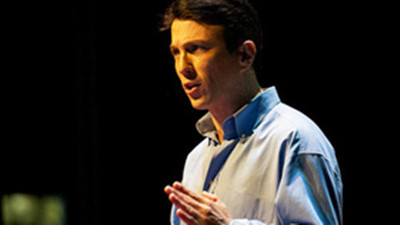(单词翻译:单击)
视频文本
And now we can see inside of the brain with a resolution and ability that was never before available,and essentially learn how to reconstruct,and maybe even re-engineer,or backwards engineer, the brain so we can better understand pathology, disease and therapy.
现在我们能看到大脑内部用一种以前没有过的分辨率和能力,本质上学会如何重建,也许甚至再设计,或者逆向设计大脑,因此我们能更好的理解病理学,疾病,和治疗。
We can look inside with real time fMRI-in the brain at real time.
我们能用fMRI即时查看内部-即时在大脑内部。
And by understanding these sorts of processes and these sorts of connections,we're going to understand the effects of medication or meditation and better personalize and make effective, for example,psychoactive drugs.
通过了解这些过程和联系,我们能够理解药物治疗或者冥想的影响从而更好的提供个人化有效的治疗,例如,精神药物。
The scanners for these are getting small, less expensive and more portable.
用于这些研究的扫描器变得更小,更便宜,更便携。
And this sort of data explosion available from these is really almost becoming a challenge.
来自这种研究的数据爆炸几乎真的成为一种挑战。
The scan of today takes up about 800 books, or 20 gigabytes.
今天的扫描占用了大约800本书的空间,或者20GB。
The scan in a couple of years will be one terabyte, or 800,000 books.
这种扫描在几年之内将会是1TB,或者80万本书。
How do you leverage that information?
你怎样利用这些信息?
Let's get personal. I won't ask who here's had a colonoscopy,but if you're over age 50, it's time for your screening colonoscopy.
让我们从个案分析。我不会问在这里谁做过结肠镜检查,但是如果你年过50,是时候做结肠镜检查了。
How would you like to avoid the pointy end of the stick?
你怎么能避免结肠镜的尖端呢?
Well now there's essentially a virtual colonoscopy.
现在有一种虚拟结肠镜检查。
Compare those two pictures, and now as a radiologist,you can essentially fly through your patient's colon and, augmenting that with artificial intelligence,identify potentially, as you see here, a lesion.
比较这两张图,现在作为一个放射学家,你可以浏览你病人的结肠用人工智能协助,确定潜在的,像你这里看到的,这是一个损伤。
Oh, we might have missed it, but using A.I. on top of radiology,we can find lesions that were missed before.
哦,我们可能漏掉它,但是在放射学上用人工智能,我们能找到以前漏掉的损伤。
And maybe this will encourage people to get colonoscopies that wouldn't have otherwise.
这也许会鼓励人们做结肠镜检查以前人们反而不愿意做它。
And this is an example of this paradigm shift.
这是一个根本变化的例子。
We're moving to this integration of biomedicine, information technology,wireless and, I would say, mobile now-this era of digital medicine.
我们转到集成了生物医学,信息技术,无线网络的交互应用,我想说,现在是移动电话-数字化医学的时代。
So even my stethoscope is now digital.
因此甚至我的听诊器现在也是数字化的。
And of course, there's an app for that.
当然,它有个应用程序。
We're moving, obviously, to the era of the tricorder.
明显我们正走向分析仪时代。
So the handheld ultrasound is basically surpassing and supplanting the stethoscope.
因此手持式超声机基本上超越并取代了听诊器。
These are now at a price point of-what used to be 100,000 euros or a couple of hundred-thousand dollars for about 5,000 dollars, I can have the power of a very powerful diagnostic device in my hand.
目前的价位,以前是10万欧元或者几十万美元,现在大约5000美元,我就能买得起一个非常强大的诊断装置。
And merging this now with the advent of electronic medical records in the United States, we're still less than 20 percent electronic.
把这个装置和电子医疗记录结合起来,在美国,电子化仍然少于百分之二十。
Here in the Netherlands, I think it's more than 80 percent.
在荷兰,我想这数据要多于百分之八十。
But now that we're switching to merging medical data,making it available electronically,we can crowd source that information,and now as a physician, I can access my patients' data from wherever I am just through my mobile device.
但是现在我们转到合并医疗数据,使它电子化,我们能够集中信息资源。现在作为一名医生,我可以从任何地方查看我的病人的数据仅通过我的手机。
And now, of course, we're in the era of the iPad, even the iPad 2.
当然,如今我们处在iPad,甚至iPad2时代。
And just last month the first FDA-approved application was approved to allow radiologists to do actual reading on these sorts of devices.
上个月首个FDA应用程序证实可以让放射专家在这些设备上直接读图。
So certainly, the physicians of today, including myself,are completely reliable on these devices.
可以确定的说,今天的医生,包括我自己,完全依赖这些设备。
And as you saw just about a month ago,Watson from IBM beat the two champions in Jeopardy.
正如你们大约一个月前看到的,来自IBM的沃特森在“危险”中打败了2位冠军。
So I want you to imagine when in a couple of years,when we've started to apply this cloud-based information,when we really have the A.I. physician and leverage our brains to connectivity to make decisions and diagnostics at a level never done.
因此我想让你们想像当我们在未来几年内,当我们开始采用这种基于云端的信息,当我们真正地有了人工智能医生来利用我们的大脑连接去做决定和诊断,在一个前所未有的技术水平上。
Already today, you don't need to go to your physician in many cases.
如今,在很多情况下你们已经不需要去看医生。
Only for about 20 percent of actual visits do you have to lay hands on the patient.
只有大约20%情况下真的需要看医生。
We're now in the era of virtual visits from sort of the Skype-type visits you can do with American Well,to Cisco that's developed a very complex health presence system.
我们正处在虚拟看病时代,从通过某种Skype视频语聊式的American Well看病,到思科研制的非常复杂的健康诊断系统。
The ability to interact with your health care provider is different.
这与给你提供健康保健医师之间的交流能力是有所不同的。
And these are being augmented even by our devices again today.
如今我们这些交流能力甚至正在被这些技术设备又增强了。
Here my friend Jessica sent me a picture of her head laceration so I can save her a trip to the emergency room-I can do some diagnostics that way.
这是我的朋友杰西卡寄给我的她头部裂伤的照片,因此她不用来急诊室-我可以通过看照片做诊断。
Or might we be able to leverage today's gaming technology,like the Microsoft Kinect,and hack that to enable diagnostics, for example,in diagnosing stroke,using simple motion detection, using hundred-dollar devices.
或者我们也许能利用今天的游戏技术,比如微软Kinect,使其能进行诊断,比如,诊断中风,用简单的移动检测,用几百元的设备。
We can actually now visit our patients robotically this is the RP7; if I'm a hematologist,visit another clinic, visit a hospital.
我们实际上现在能用机器人诊断病人,这是RP7;如果我是一个血液病专家,去另一个诊所,或医院。
These will be augmented by a whole suite of tools actually in the home now.
如果现在在家里有一整套工具,这些工具会帮助我们增强彼此的交流。
So imagine we already have wireless scales.
想像一下我们已经有了无线网络体重计。
You can step on the scale.
你可以站在体重计上。

You can Tweet your weight to your friends, and they can keep you in line.
你可以用微博把你的体重告知朋友,他们能让你保持身材。
We have wireless blood pressure cuffs.
我们有无线网络血压计。
A whole gamut of these technologies are being put together.
一整套技术正在整合在一起。
So instead of wearing these kludgy devices, we can put on a simple patch.
所以我们不用戴这些分离的装置,我们可以把它们放在一个简单的小片上。
This was developed by colleagues at Stanford, called the iRhythm with much more effectivity.
斯坦福的同事发明了iRhythm在价格上远远低于以前的技术但有效率得多。
Now we're also in the era, today, of quantified self.
现在我们处在量化自我的时代。
Consumers now can buy basically hundred-dollar devices,like this little FitBit.
人们可以买几百元的装置,像这个小FitBit。
I can measure my steps, my caloric outtake.
我可以计算出我的步数和热量消耗。
I can get insight into that on a daily basis.
我能够每天都知道了解这数据。
I can share that with my friends, with my physician.
我可以和朋友或医生分享这些数据。
There's watches coming out that will measure your heart rate, the Zeo sleep monitors,a whole suite of tools that can enable you to leverage and have insight into your own health.
这些表可以测量心律,叫做Zeo睡眠监测仪,一整套工具能让你受益并了解你自己的健康。
And as we start to integrate this information,we're going to know better what to do with it and how better to have insight into our own pathologies, health and wellness.
在我们开始整合信息时,我们会更好的了解用它做什么和怎么更好的了解我们自己的病理,健康和福利。
There's even mirrors today that can pick up your pulse rate.
现在有镜子可以测量你的脉搏率。
视频及简介
视频简介:
在马斯特里赫特的TED会议上,丹尼尔·克拉夫特快速展示了在未来几年医学上的革新,通过新工具,测试和应用程序把诊断信息直接带到患者的床边。


